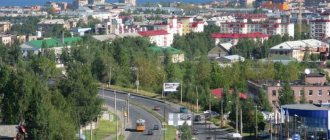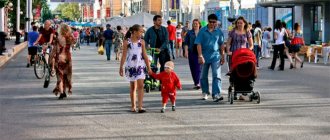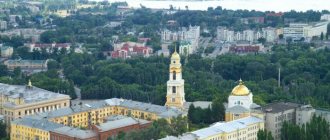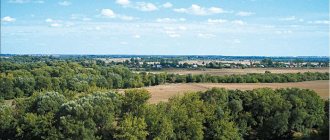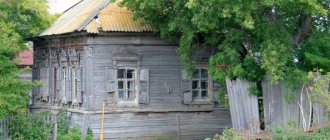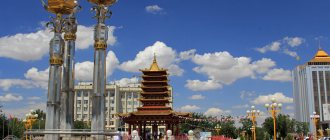17:17, August 16, 2022, PAI
Summer is slowly but surely coming to an end, but holidays and vacations are still going on. However, relaxing and going to interesting, picturesque places in the Pskov region is not prohibited at any time of the year. For a small family trip, you don’t need to look at the calendar; better study the map and this mini-navigator. After reading it, you will only need to choose the direction to your liking.
Code table
Regions in the table are sorted by number and divided for convenience into blocks according to the first digit. In parentheses after the name of the region are the years in which license plates with the corresponding region code were issued. For such regions, new codes have been introduced, which are listed at the end of the list, indicating the year of entry into force. Regions without indications in brackets use only one code, which is still valid today. To quickly obtain all the codes for a particular region, we recommend using the search form or referring to the list of regions with several codes located below the table.
Social protection of the population
According to forecasts, by 2025 the birth rate in the region will be even lower. To reduce the severity of these problems, the Main Directorate of Social Protection of the Population of the Pskov Region approved a program for 2012–2015. In accordance with it, funds were allocated to support families and combat orphanhood and mortality. The law on maternity capital is intended to help solve the problem. For those who have more than two children, the regional program provides for the allocation of land plots in the region. The size of the plots is 6–15 acres.
There are also benefits and subsidies for large families. In particular, they will pay for utilities at a reduced rate, and free medications will be provided to preschool children. For low family incomes, the law provides for payment once a month at the subsistence level.
Thus, the population of the Pskov region is rapidly declining, which is due to the simultaneous effect of many reasons. Regional authorities are making attempts to reduce the severity of this problem.
Explanations and comments
According to the Order of the Ministry of Internal Affairs of June 26, 2013 No. 478, three-digit codes with the first digit 7 (777, 779, 799, etc.) were introduced in 2013. Instead of the expected 2, the number 7 is used, since a) 2 does not fit into the space allocated for the region code on the registration plate, b) 7 is better recognized by cameras recording offenses. However, a limited series of numbers with codes 277 and 299 were still issued.
According to the Order of the Ministry of Internal Affairs of January 5, 2000 No. 5, in 2000 all license plates of the Chechen Republic were replaced: instead of code 20, code 95 was used. License plates with code 20 can no longer be found on the roads. This measure is related to counteracting the situation of accumulation of criminal vehicles at that time.
In connection with the unification and renaming of regions, changes occurred in some codes:
According to the Order of the Ministry of Internal Affairs of August 7, 2013 No. 605, when reselling a car, it is allowed to keep the old license plates. Replacement with new numbers can be carried out at the request of the new owner. Thus, linking the code on the license plate to the region of residence/registration of the owner ceases to be relevant.
Composition of the modern population
The bulk of the population of the Pskov region are Russians. Their share in the total number is 95%. The second place is occupied by Ukrainians. There are a little more than one and a half percent. The third group is completed by Belarusians, who make up approximately 1.3%. Other nationalities include Armenians, Gypsies, Estonians, Latvians, Tatars, Moldovans and other peoples.
The territorial distribution of population groups is relatively heterogeneous. In the northern part of the region, the Eastern Baltic type predominates, mixed with Finno-Ugric. In the south, the most common is the Valdai-Upper Dnieper type, associated with a mixture of Slavs and Baltic inhabitants. At the same time, there are no clear territorial and racial boundaries.
The population of the Pskov region also has some characteristic features. For example, there are traditionally many believers here, a high percentage of well-educated and cultured people. The level of patriotism is traditionally high. The latter is perhaps due to the fact that historically the inhabitants took part in many outstanding battles and this memory is passed on from generation to generation.
New format
From January 1, 2022, in accordance with Rosstandart Order N 555-ct, a new national standard of the Russian Federation GOST R 50577-2018 “State registration signs of vehicles” is approved. Types and main sizes. Technical requirements" instead of the old GOST R 50577-93. New 10 types of license plates are being introduced for vehicles, depending on the type and category of the vehicle: motorcycles, ATVs, cars with mounts for “square” license plates, sports cars, and vintage cars.
The Government is discussing the issue of changing the format of car license plates. It is planned to abandon region numbers and increase the combination of numbers and letters. Linking to a region number has now lost its relevance, since the region of registration of the vehicle owner and the region of registration of the vehicle may not coincide - motorists are allowed to keep old numbers when buying a used car. Increasing the combination of letters and numbers will avoid a shortage of options for regions with a large number of cars and will make the numbers closer to the European format. In addition, the possibility of installing electronic chips in license plates for remote reading of vehicle registration data is being discussed.
An idea from the NTI Autonet working group to introduce green license plates for electric vehicles in Russia is also being considered.
History of the population of the Pskov region
The first settlers settled in the region 10–12 thousand years ago. This happened approximately after the retreat of the ice sheet. At that time, the predominant landscape was tundra. The gradual softening of the climate contributed to an increase in the number of inhabitants. The first settlements date back to 5–6 thousand years ago. They were of the pile type and were found in the southeastern part of the region. Then the main activity was hunting (for water birds), fishing and gathering (including berries). The most ancient groups of people hunted reindeer. Dwellings were built on the sandy banks of rivers and lakes. The rise in water levels due to climate warming has led to the appearance of buildings on stilts.
About 3–4 thousand years ago, due to climate improvement, the population increased.
The main ethnic group were the Finno-Ugrians. Representatives of local and Baltic tribes also lived. Later the region was settled by the Krivichi. They became the main ancestors of the current population.
Until the 20th century, the region's birth rate was high. Its decline began after the 1917 revolution.
Description of the region
The Pskov region was formed as an administrative-territorial unit on August 23, 1944. Coordinates: 57°30′ N. w. 29°0′ E. d.
| Time in the region is now online | Geographical position |
| UTC +3, GMT+3 | |
| IANA time zone: Europe/Moscow | |
The heraldic attribute of the Pskov region is a shield, on a bright blue background of which a leopard is depicted, symbolizing courage and bravery. A cloud and a palm are illustrated at the top of the element. The coat of arms, framed by an azure ribbon with the inscription “LET’S TRY FOR THE FATHERLAND,” is decorated with a crown on top.
The flag of the region is a rectangular material, on a bright blue background of which the heraldic attribute of the region is reproduced. A pattern of triangles extends along the left side of the banner (vertically).
| Coat of arms | Flag |
The climate is temperate continental. Warm summers alternate with long and mild winters. The average annual air temperature is (+7.6°C).
Table - Climatogram of the region by year
The weather now in the Pskov region:
Source
Population of the Pskov region: general information
The population in the region in 2022 was 642 thousand people. The share of the urban population is 71%. The population density in 2017 was 11.6 people per km2.
A typical trend in the region is the outflow of people to other regions, which is reflected in the population dynamics. Mostly young people are leaving the region. Thus, the proportion of representatives of older age groups is steadily increasing. The decline in numbers occurs to a greater extent due to the rural population than the urban population. Sparsely populated areas are typical for rural settlements.
Region codes on license plates in 2022
Good afternoon, dear reader.
In this article we will talk about state registration plates (car license plates) . The numbers are assigned to the car during its registration with the traffic police and remain in place until one of the next owners decides to replace them, or the car’s registration is terminated.
Registration marks are unique, i.e. Two different cars cannot have the same number plates at the same time. The numbers always differ by at least one letter or number. Today we will look at the features and procedure for issuing license plates, as well as automobile region codes on the license plates.
Transport
The Bologoe Pskov railway connection through Dno and Porkhov crosses the area from east to west. It continues to Pechory and across the border to Tartu, although there is no rail passenger service between Pskov and Estonia. In Pskov it crosses another railway connecting St. Petersburg with Riga via Plyussa, Ostrov, Pytalovo. Gdov is connected by railway with Weimarn via Slantsy. This is part of the railway that ran south to Pskov, however the section between Gdov and Pskov was destroyed during the Second World War and was never rebuilt. In the south, the railway connecting Moscow with Riga crosses the region from east to west, passing through Velikie Luki, Novosokolniki and Sebezh. Another railway, running in the east of the region in a north-south direction, connects St. Petersburg through Dno and Novosokolniki with Nevel. At Nevel it splits into two railway lines, both going southeast to Belarus: Vitebsk, and another Grodno via Polotsk and Molodechno. Finally, Velikiye Luki is the final station of the railway running northeast to Bologoye.
The road network in the region is relatively dense, with the exception of depopulated wetlands in the east of the region. The two most important highways are the M9 Highway, which connects Moscow and Riga and runs in an east-west direction, and the M20 Highway, which connects St. Petersburg and Kiev from north to south. Near Pustoshka two roads intersect. Some sections of the road are toll. The island is the northern station of the European route E262, which goes to Kaunas via Rezekne and Daugavpils.
The region is served by airports in Pskov and Velikiye Luki. Pskov Airport (Kresty) serves regular flights to Moscow Domodedovo and St. Petersburg Pulkovo.[41] These flights are operated by Pskovavia, a local airline.
The lowest part of the Great River is navigable.
The procedure for issuing license plates in Russia
Let's consider the most common type of numbers in the Russian Federation:
These are the numbers that are installed on most cars.
At first glance, the number consists of a random sequence of letters and numbers. In fact, not everything is so simple here.
All numbers from 0 to 9 are used on license plates. However, unlike numbers, not all letters of the Russian alphabet can appear on license plates. This privilege is given only to those letters that have similar spellings in the Latin alphabet. Those. Only the letters A, B, E, K, M, N, O, R, S, T, U, X can be used on license plates.
You might have learned about this fact before, but the next thought will probably seem interesting to you. We will talk about the order in which the numbers are issued .
Nature of the area
Natural vegetation is represented by forests: both deciduous and coniferous. Therefore, picking berries and mushrooms is quite popular. Natural conditions are favorable for the development of tourism, especially water tourism.
There are many swamps and lakes in the region, including one of the largest in Europe - Lake Peipus-Pskov. They produce a rare fish called smelt.
Legacy area codes
| Code | The subject of the Russian Federation | Note |
| 20 | Chechen Republic | before 2000 |
| 80 | Transbaikal region | until 2022 |
| 81 | Perm region | until 2022 |
| 84 | Krasnoyarsk region | until 2022 |
| 85 | Irkutsk region | until 2022 |
| 88 | Krasnoyarsk region | until 2022 |
| 91 | Kaliningrad region | |
| 94 | Territories located outside the Russian Federation and served by the internal affairs bodies of the Russian Federation | until 2022 |
Content
- 1 Geography
- 2 History
- 3 Politics 3.1 First Secretaries of the Pskov Regional Committee of the CPSU
- 3.2 Governors
- 4.1 Restricted access
- 5.1 Religion
- 6.1 Industry
- 10.1 Notes
Three-digit area codes starting with the number 2
In feature films and television programs, you can see three-digit area codes starting with the number 2 or 3. For example, drivers often wonder what city regions 200, 202, 203, 211, 225, 236, 277 or 303 belong to.
Until March 26, 2022, it was illegal to install numbers with these area codes.
However, starting from March 26, 2022, absolutely any number . This issue is regulated by Appendix 1 to the order “On state registration plates of vehicles”:
Thus, if you come across a car with one of the above region codes, then you can easily determine the place of registration of its owner:
| Code | Region |
| 202 | Republic of Bashkortostan |
| 203 | The Republic of Buryatia |
| 211 | Komi Republic |
| 225 | Primorsky Krai |
| 236 | Voronezh region |
| 265 | Sakhalin region |
| 277 | Moscow |
| 303 | The Republic of Buryatia |
Note. In 2022, numbers that use the number 2 or 3 as the first character of the area code are actually not issued, because The traffic police have not yet reached the specified series.
As for numbers with codes ending with two zeros, setting such numbers is illegal, because region number 00 does not exist .
By the way, if you have seen cars with region numbers that are not in the table above, write about it in the comments.
Please note that by the number of vehicle codes belonging to a particular region, you can accurately estimate the number of vehicles in it. So the number of cars in Moscow is currently about 13.5 million.
Note. From October 15, 2013 to December 31, 2022, car owners could officially receive license plates with a region code that does not correspond to their place of registration. During this period, a large number of license plates with “foreign” region codes were issued and such cars can be found on the roads quite often. In this regard, the region code on the license plates does not always coincide with the actual place of residence of the car owner.
In 2022, when registering a car, a number with a region code corresponding to the registration of the car owner is assigned. So over time, most cars will have license plates with their own regions. And from the table above you can understand which region the car owner is from.
What interesting things do you know about license plates and the region numbers on them?
Source
Causes of the demographic crisis
One of the reasons for the demographic crisis in this region can be considered the low level of social protection of the population. The level of birth and death rates was influenced by such factors as the low level of income of the population, an upward shift in the childbearing age, the ratio of marriages and divorces, and the peculiarities of the psychology of the local population.
The reduction in the number of medical institutions affected the increase in mortality after 1960. The most negative birth/mortality ratio was in 2003. The number of obstetric and paramedic stations has decreased by almost 2 times, and the total number of medical institutions has decreased by the same amount. From 1990 to 2012 the number of ambulance stations decreased by 1/6. These trends were mainly characteristic of rural areas.
The overall mortality rate in the region exceeds the Russian average by 1.5 times. The mortality rate of infants in the Pskov region is the highest in Russia. Preventive medicine is also underdeveloped.
The level of well-being of citizens is generally very low. This leads to a large number of suicides. Social disadvantage is especially characteristic of rural areas.
However, after 2005, a weak downward trend in mortality began to emerge.
